Related Research Articles

Hỏa Lò Prison was a prison in Hanoi originally used by the French colonists in Indochina for political prisoners, and later by North Vietnam for U.S. prisoners of war during the Vietnam War. During this later period, it was known to American POWs as the "Hanoi Hilton". Following Operation Homecoming, the prison was used to incarcerate Vietnamese dissidents and other political prisoners, including the poet Nguyễn Chí Thiện. The prison was demolished during the 1990s, although its gatehouse remains a museum.

James Bond "Jim" Stockdale was a United States Navy vice admiral and aviator who was awarded the Medal of Honor in the Vietnam War, during which he was a prisoner of war for over seven years.
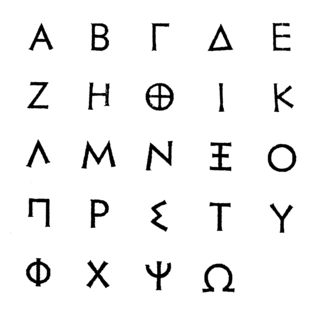
The Polybius square, also known as the Polybius checkerboard, is a device invented by the ancient Greeks Cleoxenus and Democleitus, and made famous by the historian and scholar Polybius. The device is used for fractionating plaintext characters so that they can be represented by a smaller set of symbols, which is useful for telegraphy, steganography, and cryptography. The device was originally used for fire signalling, allowing for the coded transmission of any message, not just a finite number of predetermined options as was the convention before.

Darkness at Noon is a novel by Hungarian-born novelist Arthur Koestler, first published in 1940. His best known work, it is the tale of Rubashov, an Old Bolshevik who is arrested, imprisoned, and tried for treason against the government that he helped to create.

Jeremiah Andrew Denton Jr. was an American politician and military officer who served as a U.S. Senator representing Alabama from 1981 to 1987. He was the first Republican to be popularly elected to a Senate seat in Alabama. Denton was previously a United States Navy rear admiral and naval aviator taken captive during the Vietnam War.

George Thomas Coker is a retired United States Navy commander who was awarded the Navy Cross for extraordinary heroism as a prisoner of war (POW) during the Vietnam War. An Eagle Scout, he is noted for his devotion to Scouting.
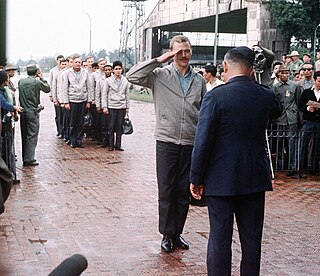
Operation Homecoming was the return of 591 American prisoners of war (POWs) held by North Vietnam following the Paris Peace Accords that ended U.S. involvement in the Vietnam War.

Douglas Brent Hegdahl III is a former United States Navy petty officer second class (E-5) who was held as a prisoner of war during the Vietnam War. After an early release, he was able to provide the names and personal information of about 256 fellow POWs, as well as reveal the conditions of the prisoner-of-war camp.
The early life and military career of John Sidney McCain III spans the first forty-five years of his life (1936–1981). McCain's father and grandfather were admirals in the United States Navy. McCain was born on August 29, 1936, in the Panama Canal Zone, and attended many schools growing up as his family moved among naval facilities. McCain graduated from the United States Naval Academy in 1958. He married the former Carol Shepp in 1965; he adopted two children from her previous marriage and they had another child together.

John Arthur Dramesi was a United States Air Force (USAF) colonel who was held as a prisoner of war from 2 April 1967 to 4 March 1973 in both Hoa Lo Prison, known as "The Hanoi Hilton", and Cu Loc Prison, "The Zoo", during the Vietnam War.
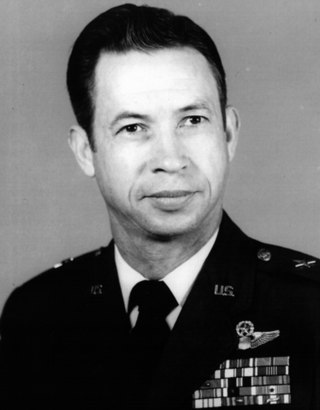
Norman Carl Gaddis, is a retired United States Air Force officer, fighter pilot and former prisoner of war. At the time he was shot down over North Vietnam, Gaddis was the most senior United States Air Force officer (Colonel).
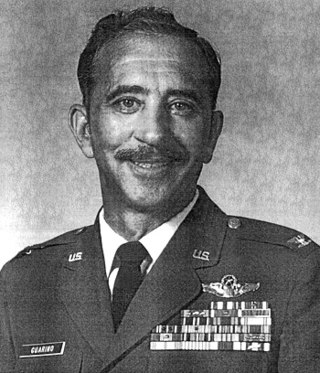
Lawrence Nicholas "Larry" Guarino was a United States Air Force officer, and veteran of three wars. Shot down on his 50th combat mission, he spent more than eight years as a prisoner of war (POW) during the Vietnam War and earned the Air Force Cross.
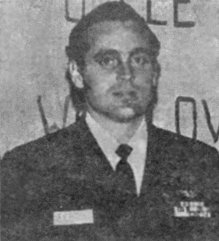
The Alcatraz Gang was a group of eleven American prisoners of war (POW) held separately in Hanoi, North Vietnam during the Vietnam War because of their particular resistance to their North-Vietnamese military captors. These eleven POWs were: George Thomas Coker, USN; Jeremiah Denton, USN; Harry Jenkins, USN; Sam Johnson, USAF; George McKnight, USAF; James Mulligan, USN; Howard Rutledge, USN; Robert Shumaker, USN; James Stockdale, USN; Ron Storz, USAF; and Nels Tanner, USN.

Leon F. "Lee" Ellis is a retired United States Air Force colonel, award-winning author, speaker, and consultant. Ellis gained notoriety when, as a fighter pilot in the Vietnam War, he was shot down, captured, and spent 5+1⁄2 years as a prisoner of war in Hanoi and surrounding areas with former presidential candidate and Senator John McCain (R-AZ) and others. His capture occurred on November 7, 1967, and he was released on March 14, 1973. He was one of the youngest, junior members in the camps. Ellis is an international speaker and consultant on the subjects of leadership and human performance, organizational integrity, operational effectiveness, and personal accountability. He frequently consults with various organizations—from small businesses to Fortune 500 organizations on these subjects. Ellis' latest book, Leadership Behavior DNA: Discovering Natural Talents and Managing Differences was published in 2020 with co-author Hugh Massie. Engage with Honor: Building a Culture of Courageous Accountability published in 2016 and his last award-winning book, Leading with Honor: Leadership Lessons from the Hanoi Hilton published in 2012, share his POW experience and the leadership principles that helped him and his compatriots resist, survive, and return with honor. His previous book, Leading Talents, Leading Teams, was published by Northfield Publishing and shares in-depth team concepts on how to lead and manage based on individual, innate gifts and talents. Additionally, Lee has co-authored three additional books and workbooks on career planning.
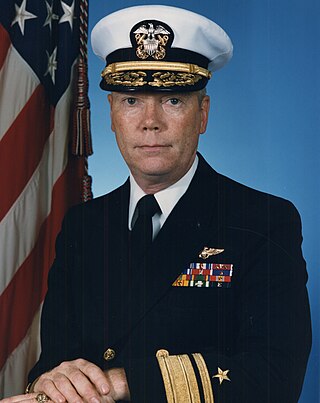
Robert Harper Shumaker is a retired rear admiral and naval aviator in the United States Navy. He spent eight years and one day as a prisoner of war (POW) in North Vietnam. He notably coined the term "Hanoi Hilton” for the notorious Hỏa Lò Prison.
The Hanoi March was a propaganda event held on July 6, 1966, involving U.S. prisoners of war during the Vietnam War. During the march, members of the North Vietnamese Army paraded 52 American POWs through the streets of Hanoi before tens of thousands of North Vietnamese civilians. The march soon deteriorated into near riot conditions, with North Vietnamese civilians beating the POWs along the 2 miles (3.2 km) route and their guards allowed the attack to happen along the March.
Members of the United States armed forces were held as prisoners of war (POWs) in significant numbers during the Vietnam War from 1964 to 1973. Unlike U.S. service members captured in World War II and the Korean War, who were mostly enlisted troops, the overwhelming majority of Vietnam-era POWs were officers, most of them Navy, Air Force, and Marine Corps airmen; a relatively small number of Army enlisted personnel were also captured, as well as one enlisted Navy seaman, Petty Officer Doug Hegdahl, who fell overboard from a naval vessel. Most U.S. prisoners were captured and held in North Vietnam by the People's Army of Vietnam (PAVN); a much smaller number were captured in the south and held by the Việt Cộng (VC). A handful of U.S. civilians were also held captive during the war.

Hayden James Lockhart is a retired United States Air Force officer who is best known for being the first U.S. Air Force pilot to be shot down in North Vietnam.

Phillip Neal "Phil" Butler is a retired United States Navy officer and pilot. He was the eighth-longest-held U.S. prisoner of war (POW) held in North Vietnam during the Vietnam War. Butler, who was forced to eject after a mid-air explosion on April 20, 1965, was a prisoner of war in North Vietnam until his release as part of Operation Homecoming in 1973. Butler was one of the five POWs credited with establishing the tap code. The code enabled the prisoners to communicate with each other.
Ronald E. Storz was a United States Air Force pilot and recipient of the Air Force Cross who died in captivity as a prisoner of war during the Vietnam War.
References
- ↑ The Handbook Of The SAS And Elite Forces. How The Professionals Fight And Win. Edited by Jon E. Lewis. p.199-Tactics And Techniques, Evasion, Capture And Escape. Robinson Publishing Ltd 1997. ISBN 1-85487-675-9
- 1 2 3 "'Return with Honor': The Tap Code". American Experience . PBS. 1999. Archived from the original on 2012-11-10. Retrieved 2008-04-08.
- ↑ "Far Outliers: Russian Prison Tapping Code". April 14, 2005. Archived from the original on August 15, 2014. Retrieved August 8, 2014.
- ↑ David Kahn, The Codebreakers – The Story of Secret Writing. 1967. ISBN 978-0-684-83130-5.
- ↑ Koestler, Arthur, Darkness at Noon (1941). Translated by Daphne Hardy. See page 19 of the Bantam Publishing paperback, 1981 printing for more info.
- ↑ Borling, John (2013). Taps on the Walls: Poems from the Hanoi Hilton. Priztker Military Library: Master Wings Publishing. pp. 1–9. ISBN 978-0-615-65905-3.
- 1 2 3 Staff Sgt. Jason Tudor (1998-03-18). "Vets, Flyers discuss ideology, time in POW camps". Air Force News Service. Archived from the original on 2007-12-03. Retrieved 2008-04-08.
- ↑ Townley, Alvin. (4 February 2014). Defiant : the POWs who endured Vietnam's most infamous prison, the women who fought for them, and the one who never returned (First edition : February 2014 ed.). New York. ISBN 9781250006530. OCLC 862575088.
{{cite book}}: CS1 maint: location missing publisher (link) - ↑ Peterson, Gordon I; Taylor, David C (March 2016). "Intelligence Support to Communications with US POW's in Vietnam". Studies in Intelligence. Center for the Study of Intelligence Publications. 60: 1–15. Archived from the original on 2019-05-08. Retrieved 2019-05-23.
- ↑ Fretwell, Peter; Kiland, Taylor Baldwin (2013). Lessons from the Hanoi Hilton: Six Characteristics of High Performance Teams. Annapolis, Maryland: Naval Institute Press. pp. 63–67. ISBN 978-1-61251-217-4.
- ↑ Hirsch, James S (2004). Two Souls Indivisible: The Friendship that saved two POW's in Vietnam . New York: Houghton-Mifflin. pp. 161-162. ISBN 0618273484.
- ↑ McCain, John; Mark Salter (1999). Faith of My Fathers. Random House. pp. 211–12. ISBN 0-375-50191-6.
- 1 2 Brace, Ernest C. (1988). A Code to Keep: The true story of America's longest held civilian prisoner of war in Vietnam. St. Martin's Press. pp. 171–72, 187–88. ISBN 0-7090-3560-8.
- ↑ Naughton, Robert J (1975). "Motivational Factors of American Prisoners of War Held by the Democratic Republic of Vietnam". Naval War College Review. 28. Archived from the original on 2019-05-04. Retrieved 2019-05-04.
- ↑ "Rough Translation: How 'Anna Karenina' Saved A Somali Inmate's Life". NPR . 2017-09-11. Archived from the original on 2023-06-26.